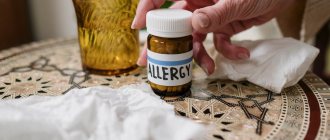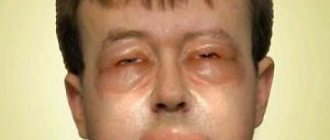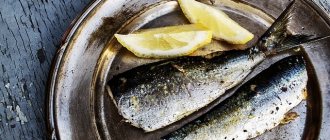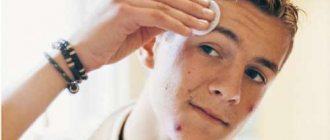One of the patients, a French teacher, told the following story: “At the beginning of her career, she was asked to help a little with translation for a Swiss journalist who flew to St. Petersburg on business. During their first meeting, the Swiss immediately asked if she knew the technique of simultaneous translation. The girl answered in the negative and decided that the interview was over, but the employer surprised her by saying that it no longer mattered, and in an hour they should be in the mayor’s reception room. At the moment of this strong experience, she accidentally saw her reflection in the mirror. The picture was frightening: the whole face and neck were covered with bright red spots, which were miraculously set off by the purple dress. For the rest of the time, she was no longer worried about how she would cope with simultaneous translation, but whether she would have time to turn pale.”
Fortunately, the story ended positively in every sense, but how many unpleasant moments can untimely vessels cause?
Skin health is largely a matter of vascular health. The physiological supply of nutrients to the skin and the normal course of thermoregulation processes are possible only with adequate functioning of the microvasculature. Normally, microcirculation is provided by the arteriolar choroid plexus (subpapillary - located on the border of the papillary and reticular layers of the dermis and subdermal - located on the border of the dermis and subcutaneous fatty tissue) and the superficial and deep venular choroid plexus.
Thermoregulation is provided by deeper vessels: mainly subcutaneous arterial and larger venous plexuses.
A number of exogenous and endogenous factors can have a damaging effect on the vascular wall:
- Hormonal and neurogenic factors
- Sharp fluctuations in high and low temperatures
- Mechanical skin damage
- Digestive diseases
- Ultraviolet irradiation
Let us consider the mechanisms of action of the most significant factors in a little more detail.
Causes of facial allergies
Atypical reactions of the immune system to foods, chemicals and biological substances can cause rashes, pimples, redness, swelling and itching. The person experiences physical and moral discomfort. The manifestations of allergic reactions are varied and depend on the individual characteristics of the body. Most often, localization is observed on the forehead, temples, cheeks, behind the ears, in the décolleté area and on the neck. The most common prerequisites for allergies are:
- heredity;
- consequences of long-term use of medications;
- unfavorable environment;
- constant stress;
- reduced immunity;
- too high a concentration of certain substances;
- insect bites;
- cold or direct sunlight.
There may be other reasons; you need to approach the problem individually.
Allergies to foods and medications
There is often cross-reaction to the protein in this group, making it difficult to find the source. The speed of onset of symptoms can vary from immediate to a period of 2-3 hours. In the case of medications, the prerequisite is overdose, long-term use, too many drugs taken during the day.
Sun or cold
The body’s response is characteristic not only of winter. This could be water or food at a certain temperature. The appearance of photodermatitis is promoted by internal and external causes. Within a day or a little later after exposure to the sun, soreness and itching of the skin begin to bother. When an allergic rash appears on the face of an adult, treatment should begin immediately, otherwise the situation will worsen with each passing hour. As part of complex therapy, immunostimulating cosmetics such as Laennec are effective. Before use, you should consult with specialists.
Reaction due to eczema
Skin diseases significantly reduce the body's resistance, and any violation provokes their exacerbation. Most often, the reaction appears externally in the form of small bubbles with liquid. The acute form can become chronic, which subsequently leads to relapses.
Errors in diet
Various dietary restrictions do not go out of fashion. There are programs based on the consumption of one or just a few products for a long time, which leads to an oversaturation of the body with certain elements, since in this case there can be no talk of balance. You should not be surprised at the deterioration in well-being, since such restrictions become the causes of severe allergies on the face of an adult, the treatment of which is carried out comprehensively and will take a lot of time.
We recommend
GHC Placental 3D Mask withQ10
Serum concentrate
Repairing cream with a moisturizing effect
Placental antioxidant lotion concentrate
Contact with animals, insect bites
A swollen nose and watery eyes when trying to pet a pet are a true classic of the genre. Mosquitoes, bedbugs and other blood-sucking creatures can also cause itching and redness on the skin. The toxins they inject in large quantities cause a rash, often accompanied by fever. In this case, external agents and antihistamines are recommended; dosages should be confirmed with a doctor.
Allergies due to stress
In addition to nervous tics, there are other reactions to emotional overload. Unconsciously, a person may scratch or clench their hands tightly. If such situations happen regularly, then health problems may begin. Itching, swelling of certain areas, redness, and difficulty breathing appear. The main direction of stabilizing the condition is the prescription of sedatives, breathing exercises aimed at calming the nervous system, ointments and gels to relieve external manifestations on the skin.
Artificial
Artificial spots on the skin are spots that appear when dyes are artificially introduced into the skin. Such spots include tattoos and contour makeup.
Any spots on the skin require close attention. They can change over time, become malignant and become life-threatening. This is especially true for so-called moles. Therefore, specialists at the Dermatology Clinic advise you to be on guard with spots and if they transform - enlargement, changes in shape and color, or itching - immediately consult a dermatologist.
Types of allergies on the face
If in children the most vulnerable area is the buttocks, where signs appear that indicate certain foods or unfavorable conditions, then in adults this is the nasolabial triangle, eyelids, lips, tongue, neck and hands.
Atopic dermatitis
Chronic inflammatory skin disease. Most often begins in early childhood. The priority prerequisite is genetic predisposition. It can be a concomitant disorder with bronchial asthma and conjunctivitis. There are infant, child and adult forms of the disease.
Hives
Allergies and rashes in the form of pimples on the face, the photo of which most often appears on advertising posters of the newest antihistamines, occurs with a seasonal variant. It is characterized by lacrimation, swelling of the eyelids, obsessive itching, and redness of certain areas of the body.
Food reactions can occur instantly when certain foods enter the mouth and esophagus. Most often they are milk, eggs, red or yellow fruits, and nuts. Peanuts are the most dangerous in this regard.
Contact dermatitis
Recognizable by clear zones of irritation. The causes are hygiene and cosmetic products, chemicals that come into contact with unprotected skin, jewelry, piercings, latex products, extracts and juices of certain plants. It manifests itself in the form of weeping erosions, in place of which dry scales then appear. To understand how to remove facial allergies, you need to find and eliminate the substance that causes your health to worsen. Often a good result comes from moving to another region. This way, it is possible to cut off some of the options; for the rest, you will have to take special tests in the laboratory.
Toxicoderma
A distinctive point is inflammation not due to external factors, but due to the penetration of a provoking substance into the body. In some cases, it can cause secondary damage to internal organs and anaphylactic shock, since it develops rapidly from the ingestion of an allergen from the inside. One way to prevent inflammation is to take antibiotics, especially penicillin. At the same time, timely treatment gives good results.
The alimentary variety is included in a special group; the deterioration of the condition is provoked not by products, but by food additives in their composition. It is quite dangerous due to the fact that it can occur suddenly, since manufacturers do not indicate all the ingredients in the composition.
Quincke's edema
It poses a direct threat to life. In the question of what an allergy on the face and neck looks like in this case, what to do and how to treat it, time is of the essence. Choking occurs quickly, and the slightest delay can have fatal consequences. An acute inflammatory reaction of the body, which occurs locally in the skin and subcutaneous tissue, affects deep layers, including the muscles of the respiratory system, and in a third of cases is localized in the larynx. It is impossible to prevent the development of Quincke's edema. Women suffer from this disorder more often. The diagnosis is made based on the clinical picture and requires medical attention. Signs may persist for several days and disappear gradually. Treatment includes the administration of potent antiallergic drugs. In severe cases, the patient requires urgent hospitalization in an intensive care unit or intensive care unit.
Pigment
Pigment spots on the skin are spots that appear as a result of an increase or decrease in the amount of melanin pigment. In case of increased pigmentation, the spots are called hyperpigmented, in case of lack of pigment or its absence, depigmented or hypopigmented.
Hyperpigmented spots on the skin are divided into:
- congenital (these include birthmarks, lentigo);
- acquired (freckles, chloasma).
Depigmented spots are divided into:
- congenital (for example, albinism);
- acquired (vitiligo, leucoderma).
Secondary depigmentation can occur in patients with psoriasis, eczema, rosea or pityriasis versicolor at the site of the primary painful rash. These rashes turn pale against the background of tanned areas of the skin because in the area of inflammation, the ability of melanocytes to produce pigment is weakened. Such areas of depigmentation are called secondary leukoderma, or pseudoleukoderma.
What does an allergy look like on the face?
There are many manifestations of allergies, and they depend on the form, location and intensity. The main indicator of the disorder is sudden swelling of the eyes and lips, one or both. Changes also affect the structure of the skin. It becomes lumpy, swollen, with a small scattering of small dots. Red, uneven spots of varying sizes often appear. Cracks and a scaly structure may be observed. If you give in to temptation and start scratching the itchy areas, the condition will quickly worsen.
Depending on the type of disorder and the affected area, allergic rashes on the face are likely, the treatment of which requires an integrated approach. Along with pharmaceutical drugs, cosmetics have a fairly good effect. Plasma therapy with the Japanese drug CURACEN perfectly restores appearance, but only after the acute period ends and the condition stabilizes.
By what characteristics should skin hyperemia be considered?
Of course, every person is concerned about their appearance, so we are most sensitive to changes on the face. But skin hyperemia will have to be assessed as a symptom in all parts of the body. There are preferential localizations associated with a specific pathology.
Hyperemia in the upper part of the body is observed with pulmonary embolism. Unfortunately, in most cases it is no longer related to treatment, but allows one to identify and correctly establish the cause of death.
Redness of almost the entire body is observed:
- under the influence of alcohol intoxication;
- in case of poisoning with narcotic drugs, scopolamine;
- in a comatose state associated with a high level of acetone in the blood;
- for first degree sunburn.
Local hyperemia of the skin can be seen over the inflamed joints of the hands and feet with arthritis, arthrosis, rheumatic and rheumatoid lesions. Here the redness does not spread to other areas, but clearly indicates the focus.
In the diagnosis of complicated varicose veins, timely detected thrombophlebitis is important. Immediately we have to change the treatment and prescribe antimicrobial drugs. And the appearance of such a symptom in the postoperative period is considered a serious complication. Therefore, surgeons’ attention is always paid to examining the skin of the lower leg and feet.
In infants, hyperemia develops in the area of skin folds, between the buttocks. Pediatricians teach mothers how to care for children, since this may be due to prickly heat, lack of necessary treatment of delicate tissues, and daily water procedures.
Skin hyperemia in discoid lupus erythematosus occurs in different areas of the skin
If pinpoint rashes appear against the background of a reddened area, then you should definitely call a pediatrician at home. This is how many infectious diseases in children and allergic diathesis can begin.
In case of skin diseases (psoriasis, acne), facial hyperemia accompanies the main elements that have arisen in the same area. The consequence of general and local therapy is itching and flaking of the skin.
With an open wound or cut, the edges of the damage are subject to an increased influx of phagocytes through the vessels to provide protection from microorganisms and the delivery of the necessary plastic materials. Moderate hyperemia of the skin under the bandage is considered a sign of sufficient immunity. The appearance of an excessively large area of bright color indicates a diffuse infection in the wound.
How to diagnose allergies
The main difficulty is to distinguish it from a skin disease. Rashes should not be a reason for panic, but a prerequisite for examination. To prevent exacerbation and speed up the process of identifying causes, it is necessary:
- try to independently identify the allergen by eliminating cosmetics or products from everyday use, doing this gradually in order to replace the changes in time;
- take an antihistamine that has already been used as prescribed by a doctor;
- Remove all alcohol-based external care products from use.
After such measures, it will be much easier to determine how to relieve an allergic reaction on the face and alleviate the general condition.
We recommend
GHC Placental 3D Mask withQ10
Serum concentrate
Repairing cream with a moisturizing effect
Placental antioxidant lotion concentrate
Reasons for appearance
Venous hyperemia is a consequence of cardiac dysfunction and should never be left to chance. Stagnation of venous blood can lead to problems such as hypoxia, atrophy, loss of tissue elasticity. The cause may also be compression of the vein due to mechanical stress or an overgrown tumor.
The causes of arterial hyperemia are:
- Allergic reactions (insect bite, flowering, dust).
- Erythrocytosis: increased levels of hemoglobin and red blood cells in the blood.
- Discoid lupus erythematosus: an autoimmune disease characterized by red, butterfly-patterned skin.
- Excessive drinking, alcoholism
- Disorders of the vascular system: vegetative-vascular dystonia, a disease of the nervous system associated with the functioning of blood vessels, hypertension, high blood pressure as a consequence of high cholesterol levels.
- Intestinal diseases, infections, tumors.
- Diseases of the nasopharynx, for example, due to acute rhinitis, nasal hyperemia may appear.
- Inflammation of the skin, such as acne.
- Hormonal imbalances. In women, they most often appear during pregnancy and menopause.
- Endocrine diseases - thyroid disorder, diabetes.
- Erythrophobia, fear of blushing.
- As a side effect when taking medications, most often hormonal.
- Injuries, bruises of skin tissue, hypothermia, sunburn, consequences of physiotherapeutic procedures, for example, laser resurfacing or peeling.
Most often, flushing of the cheeks occurs, since redness is localized in this area of the face. The lips and mouth are almost never affected by redness.
Treatment
It is not recommended to use drugs other than antihistamines on your own. In most cases, they are enough to eliminate the main symptoms and relieve swelling. It is necessary to take into account that the action must be comprehensive and must include creams, ointments and gels to relieve external signs of the disease.
Preparations for internal use
Medicines prescribed by a doctor are divided into corticosteroid and non-hormonal. The first are produced on a hormonal basis, have a powerful effect, but have a number of serious contraindications for long-term use. The second, milder ones, are prescribed to relieve mild forms of irritation. Several generations of antihistamines are available in pharmacies. If the former, such as Suprastin, influenced the level of attention, causing drowsiness and inhibition of reactions, then Cetrin, Telfast, Claritin, with high efficiency, do not give side effects that could become a limitation for work in areas where concentration is required.
Cosmeceuticals and their help in the fight against allergies
When the body reacts violently to a stimulus, skin lesions are sure to appear, and sometimes quite unpleasant ones. These are not only rashes and pimples, but also increased dryness and microcracks. Their danger lies in the possible entry of bacteria and the development of local inflammation. The main task, along with eliminating illness, is strengthening the immune system. Cosmetic products from the medical corporation "RHANA" are used in professional problem solving, provide a quick and lasting positive effect, allowing you to maintain beauty, health and prevent premature aging. And the skin is susceptible to it if an allergic reaction often appears on the face, a photo of which clearly demonstrates the degree of damage to the integument.
In order to give a fresh look and ensure cellular renewal, it is recommended to use placental preparations:
- Modeling mask with placenta hydrolyzate GHC Placental 3D Mask withQ10. It will prevent the risk of developing inflammation and give a healthy tone.
- Concentrate serum for intensive revitalization GHC Essence will instantly restore inner radiance, and also improve microcirculation and cell nutrition.
- LNC Repairing Cream with a moisturizing effect will preserve the beauty and freshness of the skin, and also protect it from moisture loss and eliminate the regeneration of ceramides (epidermal cells).
- Placental antioxidant lotion concentrate LNC Toning Lotion will protect cells, normalize melanin production and provide optimal hydration.
The dangers of self-medication
According to preliminary forecasts, the number of people reacting to certain stimuli will reach almost 90% by the end of the century. Allergists-immunologists mention the fault of allergy sufferers themselves, who, by self-medicating, expand the range of allergens and provoke the development of other diseases. In this case, the part is fixed and passed on by inheritance. By identifying the cause and drawing up an optimal treatment regimen, you can almost completely eliminate the likelihood of regular exacerbation of allergies.
Digestive diseases
Diseases of the gastrointestinal tract can indirectly affect vascular health. Irritation from the mucous membrane of the gastrointestinal tract is transmitted through the branches of the vagus nerve to its nuclei, the excitation passes to the nearby nuclei of the trigeminal nerve and through the branches of the latter enters the central zone of the face, causing vasodilation.
Recent studies confirm that the bacteria Helycobacter pylori persisting in the gastric mucosa contributes to the disruption of neurochemical regulatory mechanisms, which in turn lead to vasodilation.
Preventive measures
In order not to look with disappointment at your reflection in the mirror and not to wonder how to get rid of allergies on your face once again, you should listen to the simple but effective advice of specialists.
- Adjust the daily menu by removing from the diet foods that provoke the appearance of characteristic symptoms of an immune disorder.
- Do not use cosmetics based on alcohol and other aggressive substances, giving preference to soft and neutral ones.
- Do not stay in the sun for a long time, and in winter, protect your skin from the cold as much as possible.
- During seasonal exacerbations of hay fever, use inhaled isotonic saline solutions to reduce the concentration of pollen in the nasopharynx.
- Always keep in your medicine cabinet an antihistamine recommended by an allergist-immunologist.
It is worth remembering that angioedema alone cannot be prevented. Other types of allergies are completely preventable, and this is much more effective than constantly treating exacerbations. Immunity support should take the leading place in the list of mandatory activities.
Why are allergies on the face dangerous?
A scattering of small specks or red spots not only look unsightly, but also pose a hidden threat. Acute inflammation, accompanied by swelling, can spread to the neck and make breathing difficult.
Violation of the structure of the skin, accompanied by a feeling of tightness, reduces the natural resistance to external influences. Weeping areas, as well as cracks in the upper layer of the epidermis, create a favorable environment for the proliferation of pathogenic bacteria, which leads to the appearance of pimples and ulcers. When such a condition occurs and is not treated, there is a high probability of it becoming chronic. In addition, an unpresentable appearance can cause a sensitive blow to pride and cause problems in communication.
If an allergic rash appears on the face, a specialist from a clinic or health center will tell you how to treat it. It is better to contact him at the first signs in order to make a timely diagnosis and receive an effective treatment regimen to avoid complications.
Sharp fluctuations in high and low temperatures
The effect of cold on the condition of blood vessels should not be underestimated - the first reaction to a decrease in temperature is a sharp vasospasm in order to reduce heat transfer. Subtle mechanisms of autonomic regulation are activated, followed by compensatory vasodilation.
Many clinical symptoms of prerosacea and rosacea develop through this mechanism.
The autonomic nervous system has both direct and indirect effects on the microvasculature. Normally, the vasoconstrictor effect is exerted by norepinephrine, which acts on alpha-1 adrenergic receptors; vasodilator - adrenaline acting on beta-2 adrenergic receptors of smooth muscle cells of arterioles.
The production of acetylcholine is accompanied by dilation of the vessel and an increase in the speed of blood flow in it (due to stimulation of NO production through M receptors). This vascular response is called endothelium-dependent dilation. A mechanism of endothelium-dependent vasoconstriction associated with the synthesis of endothelin-1 and 20-HETE in the endothelium is also identified.
Autonomic dysfunctions contribute to disruption of homeostasis and adaptation of the body to various environmental influences and lead to disruption of the skin structure, increased permeability of the vascular wall, decreased barrier functions of the epidermis and create conditions for the development of inflammation in the skin.
Many clinical symptoms of prerosacea and rosacea develop through this mechanism.










